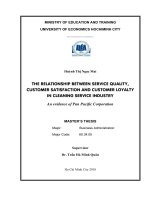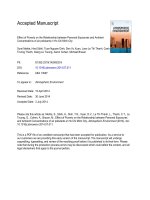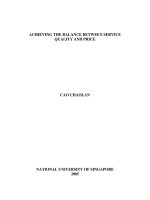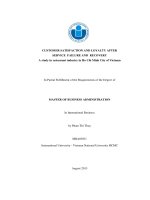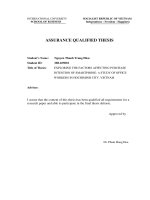The relationship between service quality and customer loyalty an empirical study on pharmasy customrrs in ho chi minh city luận văn thạc sĩ
Bạn đang xem bản rút gọn của tài liệu. Xem và tải ngay bản đầy đủ của tài liệu tại đây (946.22 KB, 85 trang )
MINISTRY OF EDUCATION AND TRAINING
UNIVERSITY OF ECONOMICS HO CHI MINH CITY
------XW------
HOANG NGOC CAM TU
THE RELATIONSHIP BETWEEN
SERVICE QUALITY AND CUSTOMER
LOYALTY: AN EMPIRICAL STUDY ON
PHARMACY CUSTOMERS IN
HO CHI MINH CITY
MASTER THESIS OF BUSINESS ADMINISTRATION
HO CHI MINH CITY – 2012
MINISTRY OF EDUCATION AND TRAINING
UNIVERSITY OF ECONOMICS HO CHI MINH CITY
------XW------
HOANG NGOC CAM TU
THE RELATIONSHIP BETWEEN
SERVICE QUALITY AND CUSTOMER
LOYALTY: AN EMPIRICAL STUDY ON
PHARMACY CUSTOMERS IN
HO CHI MINH CITY
Subject: Master of Business Administration
Code: 60.34.01.02
MASTER THESIS OF BUSINESS ADMINISTRATION
SUPERVISOR: DR. TRAN HA MINH QUAN
I
ACKNOWLEDGEMENT
For the completion of this thesis, I would like to extend my deep gratitude
to Dr. Tran Ha Minh Quan, who gave me intensive support, valuable suggestion,
guidance and encouragement during the time I conduct my thesis. Through his
guiding I found the way to conduct thesis successfully and also the way to solve
research problems.
I also want to say thankful to my classmate at eMBA K19 for their sharing
knowledge and honestly support during the time we studied and conducted thesis,
their passion to finish thesis and encouragement gave me more strength to get
over objection on the way to graduation.
Last but not least, I am grateful to my husband and my family for their
warm encouragement during the time I finished the thesis.
Although I has tried the best to complete the thesis, but errors could not be
comprehensively avoided. Therefore, I am looking forward to receiving
comments from respectful lecturers and friends, so that I can improve more on
the quality of this thesis.
Hoang Ngoc Cam Tu
Ho Chi Minh, 25 October 2012
II
COMMITMENT
I would like to commit that this thesis, “THE RELATIONSHIP
BETWEEN SERVICE QUALITY AND CUSTOMER LOYALTY: AN
EMPIRICAL STUDY ON PHARMACY CUSTOMERS IN HO CHI MINH
CITY”, was accomplished based on my independent and serious studies and
scientific researches. The data was collected in reality and it has clear origins. In
addition to that, the data would be trust-worthily handled and it has never been
released in any menu.
Hoang Ngoc Cam Tu
III
CONTENTS
ACKNOWLEDGEMENT...............................................................................I
COMMITMENT ............................................................................................ II
CONTENTS.................................................................................................. III
TABLES .........................................................................................................IV
FIGURES ........................................................................................................ V
CHAPTER I: INTRODUCTION...................................................................... 1
1.1
1.2
1.3
1.3.1
1.3.2
Problem Statement ......................................................................................1
Research Objective ......................................................................................2
Contribution.................................................................................................2
Academic Contribution..........................................................................................................................................2
Business Contribution.............................................................................................................................................3
1.4
Scope and Approach....................................................................................3
1.5
Research Structure ......................................................................................4
2.1 Service Quality......................................................................................................6
2.2 Customer Loyalty................................................................................................9
2.3 Relationship Between Service Quality and Loyalty.......................................11
3.1Research Design .................................................................................................14
3.2 Questionnaire Development .............................................................................16
3.2.1
Service quality scale..............................................................................................................................................16
3.2.2 Customer loyalty scale.........................................................................................................................................................18
3.3 Questionnaire Translation ...............................................................................19
3.4Group Discussion ...............................................................................................20
3.5 Target population..............................................................................................21
3.6 Sample size.........................................................................................................21
3.7 Selecting the sample and collecting data.........................................................22
3.8 Method of data analysis ....................................................................................23
3.8.1 Data cleaning ...........................................................................................................................................................................23
3.8.2 Reliability ..................................................................................................................................................................................23
3.8.3 Confirmatory Factor Analysis (CFA) ..........................................................................................................................24
3.8.3 Structural Equation Model (SEM)................................................................................................................................26
3.8.5 Analysis of variance (one-way and two-way ANOVA).........................................................................................27
IV
4.1 Characteristic of qualified respondents ..........................................................29
4.2 Normality analysis.............................................................................................31
4.3 Reliability of the measurements.......................................................................33
4.3.1 Reliable Test of Service Quality (SERVPERF) Measurement .........................................................................33
4.3.2 Reliable test of customer loyalty scale..........................................................................................................................36
4.4 Confirmatory factor analysis ...........................................................................36
4.5 HYPOTHESIS TESTING......................................................................... 42
4.6 Analysis of variance .................................................................................................................................................................45
4.6.1 The effect of gender on loyalty. .......................................................................................................................................45
4.6.2 The effect of age on loyalty................................................................................................................................................47
4.6.3 The effect of income on loyalty........................................................................................................................................48
5.1. Discussion on findings......................................................................................50
5.2. Practical implications.......................................................................................51
5.3. Contribution of the current study ..................................................................52
5.4 Limitations and Future research .....................................................................52
REFERENCES ...........................................................................................VIII
APPENDIX ..............................................................................................XVIII
TABLES
Table 2-1: Five Dimensions of Service quality
V
Table 2-2: Loyalty Scale
Table 3-1: Survey Items Used in The Study-Service Quality Scale
Table 3-2: Survey Items Used in The Study-Customer Loyalty Scale
Table 3-3: Assessing fit indices
Table 4-1: Variables
Table 4-2: Socio-demographic Characteristics of The Qualified respondents
Table 4-3: Assessment of Normality
Table 4-4: Reliability of Service Quality Measurement (SERVPERF scale)
Table 4-5 Reliability of loyalty measurement
Table 4-6: Composite reliability
Table 4-7: Standardized Regression Weights – Hypothesized Model
Table 4-8: Assessing Fit Indices – Modified Model
Table 4-9: Regression Weights: (Group number 1 - Default model)
Table 4-10: T-test of gender toward loyalty (BI)
Table 4-11: ANOVA Test Of Age Toward Loyalty.
Table 4-12: ANOVA Test Of Education Toward Loyalty.
Table 4-13: ANOVA test of income toward loyalty
FIGURES
Figure 2-1: The conceptual Model
Figure 3-1: The research process
VI
Figure 3-2: The translation process
Figure 4-1: CFA model
Figure 4-2: SEM result (standardized estimate)
1
CHAPTER I: INTRODUCTION
1.1 Problem Statement
From 2001 to 2008, Vietnamese pharmaceutical market has increased
significantly with average about 19.9% per year, especially in 2008 the growth
was up to 25.5% compared to 2007 (Tan et al., 2009). In recent years, with the
higher average income, Vietnamese people tend to spend more on healthcare
service. While average expense for medicine of Vietnamese people in 1998 was
just about 5.5 USD, in 2008 the average expense for medicine was 16.5 USD
and up to 19.77 USD in 2009 (Tan et al., 2009). The growth in pharmaceutical
market is attributed by increasing trend in self-medication, inline with the greater
awareness of health issues.
As end-stage in medicine distribution (along with hospitals), pharmacies has
become the most important factor to ensure the good consuming medicine
product to most of consumer, the best place for self-medication. Especially in
rural areas, where patient rather visit pharmacies than hospital for their minor
health problem, pharmacies are not only places to buy drug but also places where
patient can get fast and effective medicine for their simple disease. At
pharmacies, patient can be advised how to use medicine safety and effectively.
In Vietnam, when patient got health problem, most of them will go to
pharmacies nearby to take some medicine; this situation make the role of
pharmacies become more and more important.
2
Adapted to Ministry of Health regulation in 2007, that all pharmacies in Ho
Chi Minh City should be improved to GPP (Good Pharmacy Practices) standard
to increase service to consumer, pharmacies has been put in a new competition
for increasing infrastructure and service quality. More and more new GPP
pharmacies appeared in HCM city in year 2011 with many formalism of
increasing service: pharmacist or doctor available, economic price, gift for loyal
customer…etc. Pharmacies are doing their best to increase service quality to
attract loyal customer to maximize profit.
Aim at understanding how to improve loyalty pharmacy customer, this
research is conducted to clarify relationship between service quality and
customer loyalty.
1.2 Research Objective
To examine if any dimension of service quality, that are tangibility,
reliability, responsiveness, assurance and empathy effect on loyalty in
pharmaceutical market.
To investigate if there is any difference on mean of loyalty of
pharmaceutical consumer between demographic factors such as income, age, and
gender.
1.3 Contribution
1.3.1 Academic Contribution
3
Although there have been many studies on bank, supermarket and other
services, the study on pharmacy service is still spare. This study is one of few
studies conducted on pharmacy service. This paper contributes to the research
field of service quality and loyalty in two aspects: First, this paper examine on
pharmacy service, which is not many research have been conduct so far. Second,
this paper explores a model to demonstrate that if pharmacy loyalty is a
consequence of pharmacy service quality?
1.3.2 Business Contribution
For pharmacies: This paper examines if and how factors of service quality
affect customer loyalty so that pharmacies can chose which factor of service
quality should be improved to retain customers and maximize profit.
For retail chain of pharmacies: The understanding of relationship between
factors of service quality and customer loyalty in pharmacy market can help
retail pharmacy companies building suitable marketing strategy.
1.4 Scope and Approach
This study is conducted in HCM city, the biggest city in Vietnam. HCM city
is also the city with highest number of pharmacies nation- wide, this city is also
the 1st city to have new GPP pharmacy and pharmacy chain. With high
competition, pharmacies in HCM city also focus on increasing service quality
than in other areas.
4
Data were collected by direct interview to pharmacies customer in HCM city.
Respondents who are collected randomly are diversified at any career, age,
income, men or women and all of them are customers of different pharmacies in
HCM city.
The study is conducted in 2 main phases: pilot study and main study. The
purpose of the pilot study is to check the contents and to examine the
measurement scales. Then the main study is conducted to confirm the
measurement scales, to test the hypotheses and to confirm the research model.
1.5 Research Structure
The study is reported in 5 chapters:
Chapter 1: Introduction will provide the research background, research
objectives, as well as research scope and approach.
Chapter
2:
Literature
review
provides
theoretical
and
empirical
backgroundbehind the hypothesized research model.
Chapter 3: Methodology details the methodologies the author use to conductthis
research.
Chapter 4: Analysis is conducted based on the collected data to test
thehypotheses and answer the research questions.
Chapter 5: The author discusses the results; provide practical implication,and
possible directions for future research.
5
CHAPTER II: LITERATURE REVIEW
In this chapter, the author review about previous investigations on
relationship between service quality and customer loyalty to develop the
hypothesized model. The service quality, which has been investigated and
defined long time ago by many researchers, may be captured with perception
model (Cronin and Taylor, 1994) or captured with disconfirmation model
(Parasuraman et al., 1994). However, despite these attempts and its perceived
importance in marketing theory and practice (Jones and Sasser, 1995; Reichfeld
&Sasser, 1990), customer loyalty still “presents an enigma to researchers”
(Oliver, 1996). Implicitly, service loyalty is often incorporated as an ultimate
dependent variable in service quality models (Fornell et al., 1996), yet the
precise nature of the service quality-service loyalty connection has remained
fuzzy as the result of limited conceptualizations and contradictory empirical
results (Boulding et al., 1993;Cronin & Taylor, 1992). Most studies that have
examined the service quality-service loyalty relationship focused on one specific
industry only,limiting the general ability of results (e.g. Crosby and Stephens,
1987; Kelleyet al., 1993; Rust and Zahorik, 1993). Some results show that if
customers satisfy with service quality, they tend to repeat purchase with that
service (Chaudhuri, 1994). In this research the author examine the relationship
between service quality and customer loyalty in pharmacy service.
6
2.1 Service Quality
Service quality is difficult to evaluate clearly because services are intangibles,
heterogeneous, cannot be stored, and production and consumption are
simultaneous (Athnassopoulos et al., 2001). Researchers are interested in finding
the identification of service quality but they have not agreed how to measure it
yet. Cronin and Taylor (1992) suggest that perceptions of service quality more
closely match customer evaluation of the service provided. However,
Parasuraman et al., (1994) argue that disconfirmation is valid and further, it
allows service providers to identify gaps in the service provided. In the
disconfirmation model, service quality is defined as the comparison of service
expectations with actual performance perceptions (Parasuraman et al., 1991).
They also called SERVQUAL model. The core idea is that service quality is a
function of the difference scores or gaps between expectations and perception.
Therefore, service quality is a multidimensional concept. They find five
dimension of service quality are reliability (ability to deliver the promised
service dependably and accurately), responsiveness (willingness to help
customers and provide prompt service), assurance (ability to inspire trust and
confidence), empathy (customers are individuals) and tangibles (elements that
represent the service physically).
SERVQUAL is useful scale to measure service quality by making suitable
adjustment for industry and country contextual effect. SERVQUAL has been
proven the validity and reliability through many ranges of service fields: Tyre
7
Shop (Carman, 1990); discount and department store (Finn and Lamb, 1991;
Teas, 1993), medical services (Brown & Swartz, 1989), hospitals (Babakus
&Mangold, 1992), higher education (Boulding et al., 1993).
However, SERVQUAL is criticized for theoretical and operational issues.
Brown et al., (1993) have questioned the validity and the reliability of the
differences between expectations and performance. Tea (1993) questioned the
validity of perception-expectation gap with conceptual and operational problem
in the definition of the expectation. Cronin and Taylor (1992) have suggested
that perceptions scores alone offer a better indication of service quality, and
application of SERVQUAL is not possible in new services, but only for existing
ones.
The perceived performance model deviates from SERVQUAL model in that
expectations play a less significant role in satisfaction formation. Because the
expectation comes mainly from past experience of using service provided, but
with new services which consumers have not consume yet they lack of
experiences to compare or expect about the service they would get. Increasingly,
Mittal and Lassar (1996) are simply measuring perceptions (SERVQUAL-P) as
indicators of service quality, ignoring expectations completely. Then, Cronin and
Taylor (1992, 1996) have compared difference scores with perception to
conclude that perceptions are a better predictor of service quality than
disconfirmation. They suggested that the performance based measurement
approach (SERVPERF) is more in conformance with the existing attitude
literature and is superior to the perception-expectation gap approach.
Most recent articles have supported Cronin and Taylor's (1992) performancebased paradigm over Parasuraman et al. (1985) disconfirmation-based paradigm
8
(Oliver 1993; and Babakus and Mangold 1992). One of the most telling reviews
is provided by Boulding et al. (1993). They state "our results are incompatible
with both the one dimensional view of expectations and the gap formation for
service quality. Instead, we find that service quality is directly influenced only
by perceptions"
Table 2-1: Five Dimensions of Service quality
Service quality Definition
dimensions
Tangibility
Appearance of physical facilities, equipment, personnel and
written materials.
Reliability
Ability to perform the promised service dependably and
accurately.
Responsiveness Willingness to help customer and provide prompt service.
Assurance
Employees’ knowledge and courtesy and their ability to inspire
trust and confidence.
Empathy
Caring, individualized attention given to customers.
Adapted from Parasuraman et al., 1991
The author choose the SERVPERF scale primarily instead of
SERVQUAL because of many criticisms of SERVQUAL (Cronin & Taylor
1992; Teas, 1993; Churchill et al., 1993), and the failure of empirical studies to
replicate SERVQUAL's initial success (Carman, 1990; Babakus & Boller 1992).
Although there are many studies on diversified service such as
supermarket, fast food, banking, retail store…but there are not many studies
conducted on pharmacy service except Taylor and Cronin (1994) measure
9
service quality of professional healthcare service. One study reported in
pharmacy industry is only about the pharmacist service, not on the pharmacy as a
store (Schommer and Wiederholt, 1994).On the other hand; Bastos & Gallego
(2008) have found that SERVPERF are suitable to measure service quality in
pharmacy service. In this study, the author expects that there is a replicated
success to apply SERVPERF in pharmacy service like previous different service,
because SERVPERF has been proved to be suitable to measure service quality in
these above services.
2.2 Customer Loyalty
Customer loyalty contributes a lot on the success for a service brand.
Marketing research showed that defensive marketing referring to retaining
existing customer is superior than offensive marketing referring to capturing new
customers. For examples, Reichheld & Sasser (1990) found that lowering
customer defections can have a strong impact on company benefits and market
share. The reason is because fee for marketing of current brands is less than of a
new one. Chaudhuri (1999) claimed that customer loyalty toward a brand or
service expresses their intention to use and repeat purchase. As a consequence,
the higher loyalty toward a brand or service, the higher profit the companies gain.
Several studies have examined the association between service quality and more
specific behavioral intentions such as positive word-of-mouth, willingness to
recommend, repurchase intention. For example, Parasuraman et al. (1991) find a
positive and significant relationship between customer perceptions of service
quality and their willingness to recommend the company. Boulding et al. (1993)
10
find a positive correlation between service quality, and repurchase intentions and
willingness to recommend.
Bastos & Gallego (2008) stated that customer loyalty expressed an
intended behavior related to the product or service. Loyalty also defined as
observed behavior (Liljander & Strandvik, 1995) or actual behavior that drives
the performance of an industry. Repeat purchasing and purchasing sequence are
measures of actual behavior. Loyalty is also an attitude, expressed for example,
in the willingness to recommend a service provider to other consumers (Selnes,
1993). Loyalty is also cognitive, that could be operationalized as a product or
service that comes first to mind when making a purchase decision or the product
or service that is the first choice among alternatives (Ostrowski et al., 1993), or
price tolerance (Anderson, 1996; Fornell et al., 1996).
For the construction of service loyalty the constructs are more diversified.
Meanwhile the investigations of Bloemer et al. (1998), Bloemer (2002) and
Zeithaml et al. (1996) are the best contributions to the research. The
measurements of loyalty are as follow.
11
Table 2-2: Loyalty Scale
Number Items wording
of items
1
Say positive things about XYZ to other people
2
Recommend XYZ to someone who seek for your advices
3
Encourages friends and relative to do business with XYZ.
4
Consider XYZ your first choice to buy.
5
Do more business with XYZ in the next few years
Source: Zeithalm et al., 1996.
2.3 Relationship Between Service Quality and Loyalty
The relationship between service quality and customer preference loyalty
has been examined in different research. Cronin and Taylor (1992) focused
solely on repurchase intentions, whereas Boulding et al. (1993) focused on the
elements of repurchasing and willingness to recommend. However, while Cronin
and Taylor did not find significant positive effect of service quality on
repurchase intentions (in contrast to the significant positive relation between
satisfaction and repurchase intention), Boulding et al. (1993) found positive
relationships between service quality and repurchase intentions and willingness
to recommend.
Furthermore, there are a number of factors that limit a comprehensive
understanding of service quality and its impact on customer loyalty in service
and prevent the generalization of research findings. First, the construct of
customer loyalty remain limited, as it ignores the full range of conceivable
12
loyalty action that may follow the evaluation of the service (Zeithalm et al.,
1996). Second, the link between the individual dimensions of service quality and
customer loyalty received relatively little research attention.
However, recent research gives some evidence that service quality has an
impact on customer satisfaction, which in turn leads to later behavior toward the
service firm (Cronin &Taylor, 1992; Anderson & Sullivan, 1993). Furthermore,
Bloemer &Ruyter (1998) find a positive relationship between service quality and
service loyalty in five different service industries. Similarly, in another study
conducted by Wong et al. (1999), a positive relationship was found between
service quality and customer loyalty.
Indeed, most of the studies linking service quality and behavioral
intentions have been conducted in one specific service setting. For instance, Rust
and Zahorik (1993) relate service quality perceptions to consumer loyalty in
banking, Crosby and Stephens (1987) investigate loyalty in the insurance
industry and with regard to retailing, customer patronage was investigated in
relation to service encounter failures by Kelley et al. (1993).However, there is
very limited research to examine the direct relationship between service quality
and customer loyalty in pharmacy service, although relationship between service
quality and customer satisfaction has been examined in some studies (Hayashi et
al. (2005), Kamei et al. (2001)). Bastos & Gallego (2008) do not find out a
significant direct relationship between service quality and customer loyalty in
pharmaceutical market.
Although prior research has not comprehensively examined the impact of
service quality on service loyalty dimensions, the author expect, in accordance
with Zeithaml et al. (1996), positive relationships between service quality and
13
customer loyalty. This leads to the following hypotheses:
Hypothesis 1, 2, 3, 4, 5: Tangibility, reliability, assurance, responsiveness and
empathy have direct positive effect on Loyalty
Figure 2-1: The conceptual Model
Tangibility
Reliability
Assurance
Responsivenes
H1
Boulding et al. (1993); Zeithalm et al.(1996)
H2
H3
H4
H5
Assurance
Source: Cronin and Taylor (1992);
Loyalty
14
CHAPTER III: RESEARCH METHODOLOGY
The purpose of this chapter is to address the methods used in this study.
Items that will be addressed include research design, questionnaire development,
questionnaire translation, pilot study, target population, sample frame, sample
size, sample selection, sample characteristics, data collection and methods of
data analysis.
3.1Research Design
The study contained 2 main phases: Pilot study and main study.
Pilot study was conducted by qualitative method to explore, adjust items
to measure research concepts. Based on the literature, the 1st draft questionnaire
was translated from English to Vietnamese and back by two professional
translators and was use to discuss in focus group. One group of 10 pharmacy
customers (5 men and 5 women, who are from 25 to 32 years old) was invited to
a focus group in HCM city. The purpose of the focus group was to check if
meaning and content of the questionnaire are understood exactly and, to
adjust/add more or delete any items which were not suitable in Viet Nam market.
With result from focus group, 1st draft questionnaire was adjusted to final
questionnaire for the main study.
15
Main study was conducted on 310 pharmacy customers in HCM city by
direct interview. The purposes were to test the measurement scales, the
hypotheses and the research model. 40 of 310 responses were excluded if there
were unanswered questions of the whole questionnaire or illogical answer. 270
other responses were test reliability, CFA and SEM.
Figure 3-1: The research process
LITERATURE REVIEW
(Develop research model and hypotheses)
GROUP DISCUSSION
10 attendants
(To check measurement scale wording
and adjust the scale)
THE MAIN STUDY USING THE
FINAL QUESTIONNAIRE
(Direct interview 270 customer)
REPORT WRITING
The first draft of
questionnaire
The final
questionnaire
Test Reliability
CFA, SEM
CFA: Confirmatory Factor
Analysis
SEM: Structural Equation Model
16
3.2 Questionnaire Development
The survey contained 2 sections including service quality, and customer
loyalty. All items were assessed on Likert-type scales on which 1 represents
“strongly disagree” and 7 represents “strongly agree”.
3.2.1 Service quality scale
Service quality scale was based on SERVPERF scale (Cronin and Taylor,
1992) which was used in previous study of many services. This instrument
measured 5 dimensions of service quality:
Tangibility: This dimension captured tangible facilities of pharmacy
included costume and appearance of the pharmacy employees, pharmacy
installation and equipment in view of service.
Reliability: This dimension captured pharmacy ability to conduct service
on time and same as their commitment at the first time.
Responsiveness:
This
dimension
captured
pharmacy’s
employee
capability to be willing to serve customer punctually.
Assurance: This dimension captured pharmacy’s employee professional
knowledge, polite and warm service to customer.
Empathy: This dimension captured that pharmacy’s employee take care
customer individually.
17
Table 3-1: Service Quality Scale
Tangibility
TG1
This pharmacy has modern equipment.
TG2
The installations of this pharmacy are visually agreeable.
TG3
The employees of this pharmacy have an agreeable aspect.
TG4
The equipment of this pharmacy are in view of the service
Reliability
RE1
This pharmacy does what it promises.
RE2
When I have a problem, this pharmacy demonstrates interest in it
resolution.
RE3
This pharmacy does the service well at first time.
RE4
This pharmacy does the service in the promised time
RE5
In this pharmacy does not commit errors.
Responsiveness
RS1
This pharmacy has a quickly attendance.
RS2
The employees of this pharmacy inform you conveniently
RS3
The employees of this pharmacy aren’t ever occupied to answer to your
questions.
RS4
The employees of this pharmacy are always prepared to help you.
Assurance
AS1
The behavior of the employees of this pharmacy inspires confidence to
the customers.
AS2
You feel secure when you buy this pharmacy.
AS3
The employees of this pharmacy are always pleasant.
AS4
The employees of this pharmacy have sufficient knowledge’s to answer to




